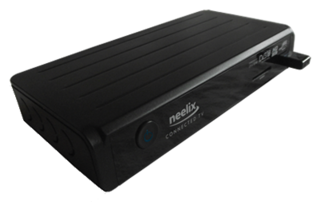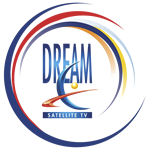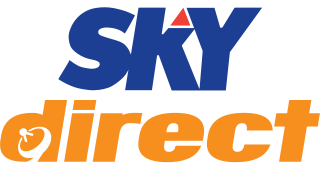
Cable television is a system of delivering television programming to consumers via radio frequency (RF) signals transmitted through coaxial cables, or in more recent systems, light pulses through fibre-optic cables. This contrasts with broadcast television, in which the television signal is transmitted over-the-air by radio waves and received by a television antenna attached to the television; or satellite television, in which the television signal is transmitted over-the-air by radio waves from a communications satellite orbiting the Earth, and received by a satellite dish antenna on the roof. FM radio programming, high-speed Internet, telephone services, and similar non-television services may also be provided through these cables. Analog television was standard in the 20th century, but since the 2000s, cable systems have been upgraded to digital cable operation.

A set-top box (STB), also known as a cable box or receiver and historically television decoder or a converter, is an information appliance device that generally contains a TV-tuner input and displays output to a television set and an external source of signal, turning the source signal into content in a form that can then be displayed on the television screen or other display device. They are used in cable television, satellite television, and over-the-air television systems as well as other uses.
Television receive-only (TVRO) is a term used chiefly in North America, South America to refer to the reception of satellite television from FSS-type satellites, generally on C-band analog; free-to-air and unconnected to a commercial DBS provider. TVRO was the main means of consumer satellite reception in the United States and Canada until the mid-1990s with the arrival of direct-broadcast satellite television services such as PrimeStar, USSB, Bell Satellite TV, DirecTV, Dish Network, Sky TV that transmit Ku signals. While these services are at least theoretically based on open standards, the majority of services are encrypted and require proprietary decoder hardware. TVRO systems relied on feeds being transmitted unencrypted and using open standards, which heavily contrasts to DBS systems in the region.

Digital Video Broadcasting (DVB) is a set of international open standards for digital television. DVB standards are maintained by the DVB Project, an international industry consortium, and are published by a Joint Technical Committee (JTC) of the European Telecommunications Standards Institute (ETSI), European Committee for Electrotechnical Standardization (CENELEC) and European Broadcasting Union (EBU).
DigiCipher 2, or simply DCII, is a proprietary standard format of digital signal transmission and it doubles as an encryption standard with MPEG-2/MPEG-4 signal video compression used on many communications satellite television and audio signals. The DCII standard was originally developed in 1997 by General Instrument, which then became the Home and Network Mobility division of Motorola, then bought by Google in Aug 2011, and lastly became the Home portion of the division to Arris.

Multichannel multipoint distribution service (MMDS), formerly known as broadband radio service (BRS) and also known as wireless cable, is a wireless telecommunications technology, used for general-purpose broadband networking or, more commonly, as an alternative method of cable television programming reception.
Digital cable is the distribution of cable television using digital data and video compression. The technology was first developed by General Instrument. By 2000, most cable companies offered digital features, eventually replacing their previous analog-based cable by the mid 2010s. During the late 2000s, broadcast television converted to the digital HDTV standard, which was incompatible with existing analog cable systems.
Free-to-air (FTA) services are television (TV) and radio services broadcast in unencrypted form, allowing any person with the appropriate receiving equipment to receive the signal and view or listen to the content without requiring a subscription, other ongoing cost, or one-off fee. In the traditional sense, this is carried on terrestrial radio signals and received with an antenna.
Pirate decryption is the decryption, or decoding, of pay TV or pay radio signals without permission from the original broadcaster. The term "pirate" is used in the sense of copyright infringement. The MPAA and other groups which lobby in favour of intellectual property regulations have labelled such decryption as "signal theft" even though there is no direct tangible loss on the part of the original broadcaster, arguing that losing out on a potential chance to profit from a consumer's subscription fees counts as a loss of actual profit.

VideoCipher is a brand name of analog scrambling and de-scrambling equipment for cable and satellite television invented primarily to enforce Television receive-only (TVRO) satellite equipment to only receive TV programming on a subscription basis.
Television encryption, often referred to as scrambling, is encryption used to control access to pay television services, usually cable, satellite, or Internet Protocol television (IPTV) services.
QAM is a digital television standard using quadrature amplitude modulation. It is the format by which digital cable channels are encoded and transmitted via cable television providers. QAM is used in a variety of communications systems such as Dial-up modems and WiFi. In cable systems, a QAM tuner is linked to the cable in a manner that is equivalent to an ATSC tuner which is required to receive over-the-air (OTA) digital channels broadcast by local television stations when attached to an antenna. Most new HDTV digital televisions support both of these standards. QAM uses the same 6 MHz bandwidth as ATSC, using a standard known as ITU-T Recommendation J.83 Annex B ("J.83b").

Satellite television is a service that delivers television programming to viewers by relaying it from a communications satellite orbiting the Earth directly to the viewer's location. The signals are received via an outdoor parabolic antenna commonly referred to as a satellite dish and a low-noise block downconverter.

A free-to-air or FTA Receiver is a satellite television receiver designed to receive unencrypted broadcasts. Modern decoders are typically compliant with the MPEG-2/DVB-S and more recently the MPEG-4/DVB-S2 standard for digital television, while older FTA receivers relied on analog satellite transmissions which have declined rapidly in recent years.
Cable television piracy is the act of obtaining unauthorized access to cable television services. It is a form of copyright infringement and a federal crime. Reception of cable television without authorization by a cable operator is forbidden by both federal and state laws. In Missouri, cable television piracy is usually a class A misdemeanor; if the service is $500 or more, it is classified as a class C felony.

A cable converter box or television converter box is an electronic tuning device that transposes/converts channels from a cable television service to an analog RF signal on a single channel, usually VHF channel 3 or 4, or to a different output for digital televisions such as HDMI.
When a descrambler is added to the Cable Converter Box in the same chassis, it is referred to as a Converter/Descrambler or sometimes a Combination Unit, and is a type of Set-top box, it allows : local broadcast channels, basic cable channels, authorized premium channels, "Pay-Per-View" (PPV), and “Video On Demand” (VOD) services to be viewed. A Combination Converter/Descrambler is generally called a Set-top box or STB it is a single (one-piece) system installed in a single cabinet and represents a single component that is capable of descrambling premium services, like HBO or Showtime, pay-per-view cable channels., Video on Demand, Games or other specialty pay services, and transposes the cable signal for RF output on channel 3 or 4. This unit contains a converter and a descrambler, enclosed in a common box and outputs the signal directly to a TV, VCR, DVR, PC, DVD or video projector.

Dream Satellite TV was the first all-digital Direct-To-Home (DTH) television broadcasting service via satellite in the Philippines. Broadcasting from the Dream Broadcast Center located at the Clark Special Economic Zone in Pampanga. Content is received from program providers, compressed and broadcast via Koreasat 5 in DVB-S and NTSC color format exclusively to its subscribers using the Integrated Receiver-Decoder and the Conax/Nagravision 3 Encryption System.
Cable first started in 1963, when several companies, including state broadcaster RTÉ, started relaying the UK's terrestrial TV channels in some cities and larger towns. Today all Irish cities and many larger towns have cable networks.

Sky Direct was a direct-broadcast satellite subscription television service in the Philippines owned and operated by Sky, a subsidiary of ABS-CBN Corporation. Sky Cable had been eyeing for a DBS service and considered on acquiring Dream Satellite TV from Antonio O. Cojuangco, Jr. The acquisition of Dream was reported to have reached an advanced stage but for some undisclosed reasons, the deal was not sealed. Sky's entry to the DBS market was hindered by various oppositions from the industry, citing legal issues and the slow growth of the pay TV market in the country. On December 23, 2015, Sky was granted by the NTC a provisional authority to operate and maintain a DBS service in 251 cities and municipalities in the country for a period of 18 months. Sky Direct offered both prepaid and postpaid packages with exclusive channels from ABS-CBN and Creative Programs such as ABS-CBN HD, ABS-CBN News Channel, ABS-CBN Sports+Action HD, Cinema One, Jeepney TV, Metro Channel, Liga, and Myx. As of March 2019, Sky Direct had over 1 million subscribers.










